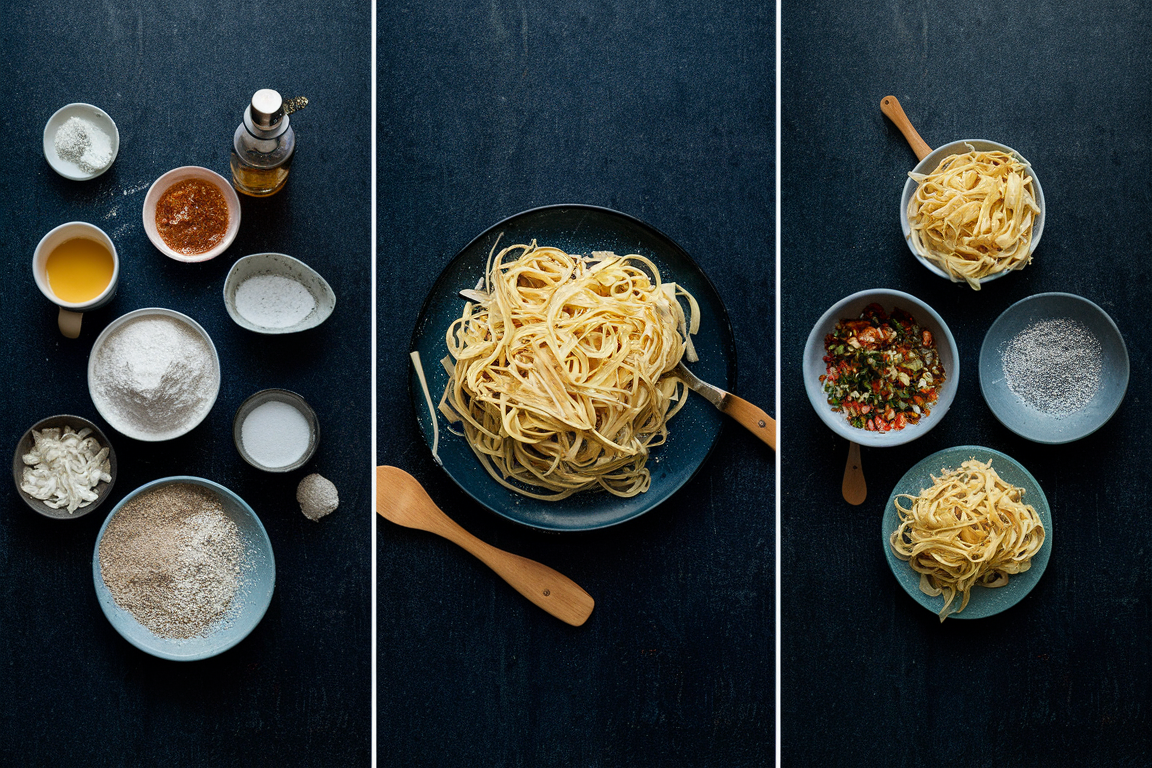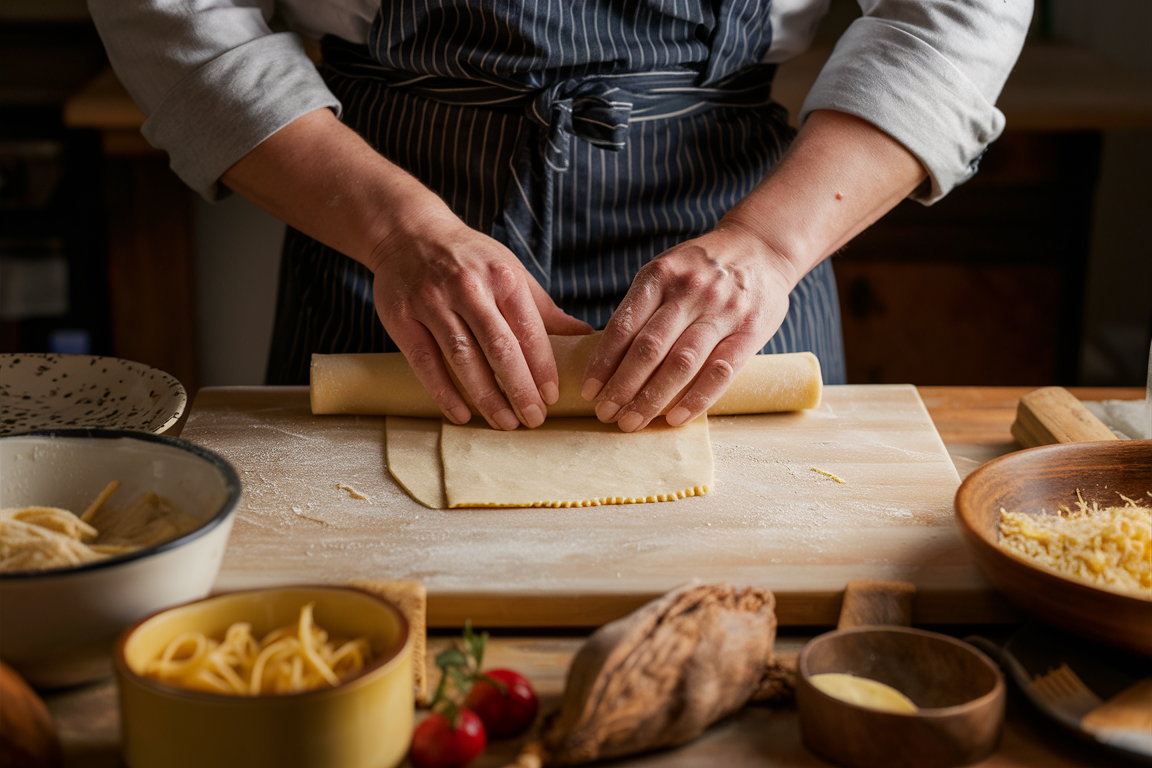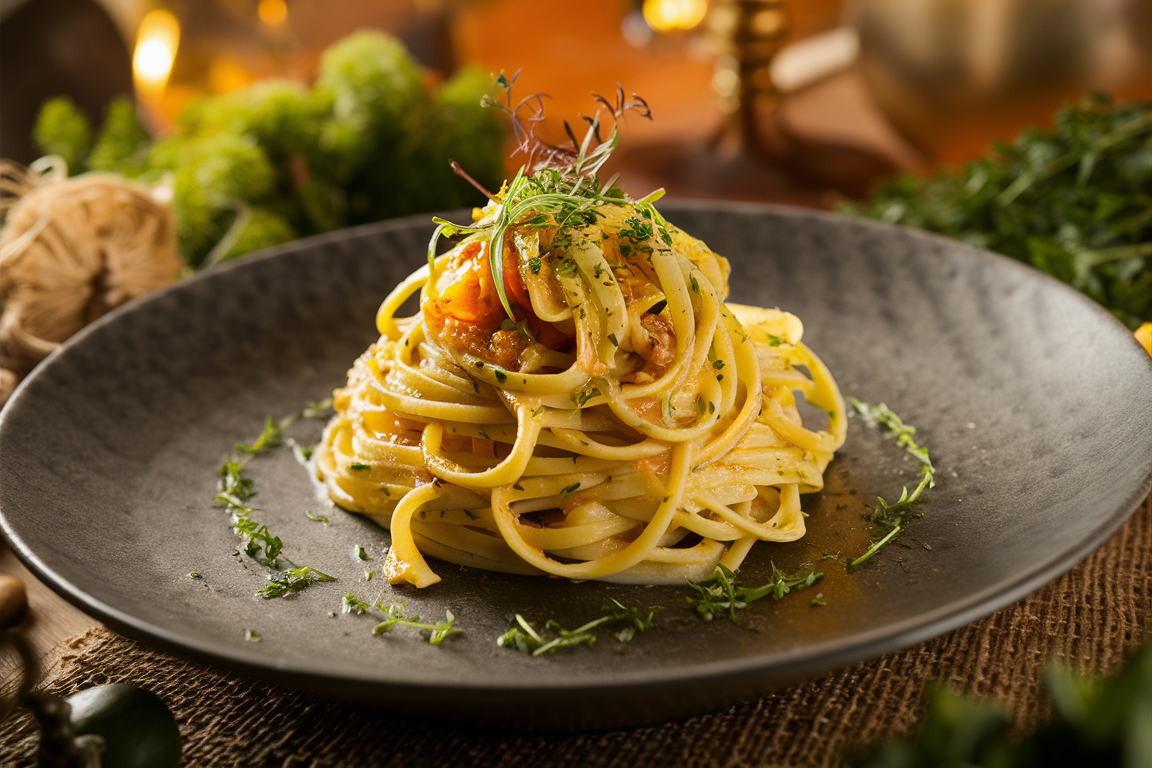Jump ahead to:
Introduction to the Rich World of Tagliolini Pasta
Welcome to the delightful world of Tagliolini Pasta, a true Italian staple. It embodies simplicity and taste. This article will reveal the secrets of making Tagliolini. You’ll learn about the basic ingredients and traditional techniques. Additionally, we’ll explore various serving methods. This ensures you can add Italian elegance to your dining table. So, buckle up as we embark on this culinary journey, uncovering the history, variations, and modern twists of Tagliolini Pasta.
Overview of Tagliolini
Definition and Origin
Tagliolini, also known as Italian thin pasta, is a traditional type of pasta from Italy, similar to spaghetti but thinner. Originating from the Piedmont and Liguria regions of Italy, Tagliolini is typically made from wheat flour and eggs, giving it a rich flavor and delicate texture that’s ideal for absorbing sauces.
Distinction from Other Pasta Types
Unlike its cousin, tagliatelle, which is broader, Tagliolini is narrow and often coiled into small nests for cooking. This shape and size make it perfect for lighter sauces, such as a simple butter herb sauce or a seafood-based condiment. The unique attributes of Tagliolini set it apart in the vast family of pasta, making it a favorite for those who cherish subtle elegance in their meals.
Ingredients Required for Making Tagliolini Pasta
Basic Ingredients List
Creating Tagliolini requires just a few fundamental ingredients, making it a testament to the beauty of Italian simplicity. You’ll need:
- Flour: Typically, a fine ’00’ grade wheat flour is used for its smooth texture.
- Fresh eggs: These bind the flour and enrich the pasta with a tender, rich quality.
Optional Ingredients for Flavor Enhancement

To elevate your Tagliolini, consider these additions:
- Olive oil: A dash can add a subtle richness.
- Salt: Just a pinch can enhance the natural flavors of the pasta.
Preparation Method for Tagliolini

Step-by-Step Guide to Making Tagliolini at Home
- Mix the Ingredients: Start by placing the flour on a clean surface, making a well in the center. Crack the eggs into the well and add a pinch of salt and a splash of olive oil.
- Knead the Dough: Slowly incorporate the flour into the eggs and oil, kneading until the mixture forms a smooth, elastic dough. This might take about 10 minutes of kneading.
- Rest the Dough: Wrap the dough in cling film and let it rest at room temperature for about 30 minutes. Resting helps the gluten in the dough relax, making it easier to shape.
- Roll Out the Dough: Once rested, divide the dough into smaller pieces. Using a pasta machine or a rolling pin, roll each piece until it’s very thin. The dough should be almost translucent.
- Cut the Pasta: Cut the thin dough sheets into narrow strips to form the Tagliolini. If you don’t have a pasta cutter, a sharp knife will do the job just fine.
- Cook the Pasta: Boil a large pot of salted water. Cook the Tagliolini for about 2-3 minutes, or until they float to the surface, indicating they are ready.
Tips for Perfect Dough and Pasta Texture
- Consistency is key; ensure your dough is neither too sticky nor too dry. Adjust by adding a little more flour or a few drops of water if necessary.
- When rolling the dough, keep it thin; this is crucial for achieving the delicate texture that Tagliolini is famous for.
- Avoid overcooking the pasta to maintain its subtle chewiness, a hallmark of perfectly made Tagliolini.
This detailed guide not only helps you recreate Tagliolini at home but also brings a piece of Italian culinary art into your kitchen. Enjoy the process and the delicious results!
Culinary Significance of Tagliolini Pasta
Traditional Tagliolini Dishes
Tagliolini has graced Italian tables for centuries, primarily featured in recipes that emphasize its delicate texture and quick cooking time. A classic dish is Tagliolini al tartufo, where thin pasta ribbons are tossed with butter and truffles, showcasing the pasta’s ability to complement subtle yet distinct flavors.
In the Liguria region, chefs often serve Tagliolini with a pesto sauce, which highlights the fresh, aromatic basil thriving in the area. Meanwhile, in Piedmont, chefs take a heartier approach by serving Tagliolini under a robust meat ragù, especially during festive occasions.
Regional Variations in Italy
Each region adapts Tagliolini to its local tastes and ingredients. For instance, coastal areas might pair it with seafood, embracing the bounty of the Mediterranean. Conversely, inland regions might prefer richer sauces, incorporating local meats and cheeses to create a more filling meal.
Modern Twists on Tagliolini
Chefs around the world have taken Tagliolini and introduced it to a variety of global flavors, resulting in innovative and exciting dishes. One such modern twist is Tagliolini with saffron and seafood, where the spice’s vivid color and unique flavor make the dish a visual and gastronomic delight.
Fusion dishes also emerge, such as Tagliolini with Japanese-inspired sauces, like a delicate miso butter, which merges the umami-rich miso paste with traditional Italian butter sauces, creating a silky, savory coating for the pasta.
These contemporary takes on Tagliolini not only honor its traditional roots but also push the boundaries of pasta cuisine, inviting food lovers to explore new tastes and combinations. Whether sticking to the classics or experimenting with new flavors, Tagliolini remains a versatile and beloved component of the culinary world.
Serving and Pairing Tagliolini Pasta
Best Practices for Serving
When serving Tagliolini, presentation is key. It’s best to twirl the pasta gently on a fork and place it neatly in the center of a shallow bowl to highlight its delicate structure. Garnishing with a sprinkle of fresh herbs, such as basil or parsley, can add a pop of color and freshness.
Serve Tagliolini warm, ideally immediately after cooking, to maintain its texture and warmth, enhancing the dining experience. The temperature at which it is served brings out the best in the pasta’s flavor, especially when coated in light sauces.
Pairing Ideas for Modern Recipes
While traditional Tagliolini dishes pair wonderfully with light white wines, modern recipes might call for more robust options. For instance, a Tagliolini dish with a creamy sauce might pair well with a medium-bodied white like a Chardonnay, which can complement the richness without overwhelming the flavor. For spicier or more aromatic dishes, consider a Riesling, which can balance the heat and spice with its sweetness and acidity.
Exploring these pairings can enhance the overall meal, making each bite of Tagliolini even more enjoyable. Whether sticking to tradition or experimenting with new combinations, the right drink can elevate your pasta dish to new culinary heights.
Nutritional Information of Tagliolini Pasta
Health Benefits
Tagliolini, a classic Italian pasta, offers more than just taste; it provides nutritional benefits too. Rich in carbohydrates, it serves as an excellent energy source. When made with whole wheat flour, Tagliolini also delivers a good dose of dietary fiber, which aids in digestion and sustained energy release.
This pasta is a source of protein as well, especially when eggs are included in the dough. Moreover, incorporating egg in the pasta increases the levels of essential amino acids. It’s important for those monitoring their diet to consider portion size to balance calorie intake with energy expenditure.
Allergens and Alternatives
The primary allergens in Tagliolini are gluten and eggs, making it unsuitable for those with allergies to these components. However, there are several alternatives available:
- Gluten-free Tagliolini can be made using rice flour or a mix of corn and rice flour, offering a similar texture without the gluten.
- For those avoiding eggs, egg-free pasta varieties are available, or one can opt to make pasta using water and flour only, which also suits vegan diets.
Exploring these alternatives ensures that everyone can enjoy the delights of Tagliolini, regardless of dietary restrictions.
Nutritional Information of Tagliolini Pasta
Health Benefits
Tagliolini, a classic Italian pasta, offers more than just taste; it provides nutritional benefits too. Rich in carbohydrates, it serves as an excellent energy source. When made with whole wheat flour, Tagliolini also delivers a good dose of dietary fiber, which aids in digestion and sustained energy release.
This pasta is a source of protein as well, especially when eggs are included in the dough. Moreover, incorporating egg in the pasta increases the levels of essential amino acids. It’s important for those monitoring their diet to consider portion size to balance calorie intake with energy expenditure.
Nutritional Content (Per 100g)
Below is a table detailing the typical nutritional values for Tagliolini per 100 grams:
| Nutrient | Amount |
|---|---|
| Calories | 350 kcal |
| Protein | 12 g |
| Carbohydrates | 71 g |
| Fat | 1.5 g |
| Fiber | 3 g |
| Sodium | 6 mg |
Allergens and Alternatives
The primary allergens in Tagliolini are gluten and eggs, making it unsuitable for those with allergies to these components. However, there are several alternatives available:
- Gluten-free Tagliolini can be made using rice flour or a mix of corn and rice flour, offering a similar texture without the gluten.
- For those avoiding eggs, egg-free pasta varieties are available, or one can opt to make pasta using water and flour only, which also suits vegan diets.
Exploring these alternatives ensures that everyone can enjoy the delights of Tagliolini, regardless of dietary restrictions.
Frequently Asked Questions About Tagliolini Pasta
What is the difference between tagliolini and tagliatelle?
Tagliolini and tagliatelle are both traditional Italian pastas but differ mainly in shape and serving style. Tagliolini is a thin, ribbon-like pasta, narrower than tagliatelle, and often rolled up into small nests. It is ideal for lighter sauces or broths due to its delicate structure. In contrast, tagliatelle is wider and flatter, making it better suited for thicker, creamier sauces which cling to the broader surface area.
How should tagliolini be cooked for optimal texture?
To achieve the perfect texture, tagliolini should be cooked in a large pot of salted boiling water for about 2-3 minutes. Because of its thinness, it cooks quickly and can become mushy if overcooked. The goal is to reach ‘al dente’ — tender but still slightly firm to the bite. Once done, it’s best to mix tagliolini immediately with the sauce to prevent sticking and to ensure that the pasta absorbs the flavor of the sauce evenly.
Can tagliolini be used in soups?
Absolutely! Tagliolini is excellent in soups. Its thin, delicate nature allows it to cook quickly within a broth, making it a perfect choice for light and brothy soups such as minestrone or a simple chicken broth. When using tagliolini in soups, add the pasta towards the end of the cooking process to avoid overcooking and to maintain its texture. This will ensure that the tagliolini retains a slight bite, enriching the overall experience of the soup.
Conclusion
Tagliolini holds a cherished spot in Italian culinary tradition, celebrated for its delicate texture and versatility in pairing with a variety of sauces and dishes. This pasta not only brings the flavors of Italy to your table but also invites creativity in the kitchen. Whether you’re crafting a simple, buttery dish or experimenting with bold, innovative recipes, Tagliolini provides a perfect canvas. Embrace the joy of making and savoring your own Tagliolini, and let each meal be a celebration of rich culinary heritage.

